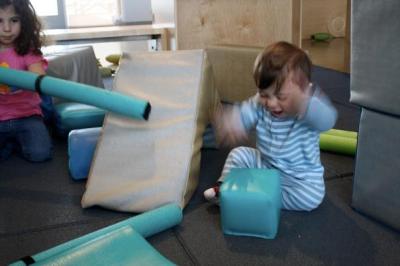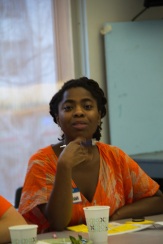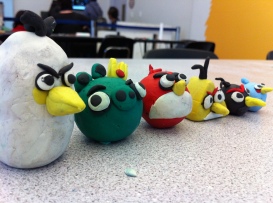By Emmy Brockman

“Children learn as they play. Most importantly, in play children learn how to learn.” -O. Fred Donaldson (Pulitzer nominated author, and renowned play researcher)
Last week, at Children’s Creativity Museum, I observed the following scene: A boy – 3.75 years old by his own account – and his mother are building with large soft blocks. I will call the boy Alex. “It’s fort building time!” announces Alex.
“ What kind of fort are we building?”
“ A no more alligator fort!”
Alex runs to the puppet area and comes back carrying two alligator puppets and one dragon puppet. He hands the dragon to his mom. “This fort is not for you!” he tells the dragon. Knock knock knock on the fort. “Is it dragon time?” asks the dragon. A 20-month-old girl then approaches (I’ll call her Kelly), and mimics the dragon, knocking on the fort. Kelly smiles and Alex joins her in knocking. The dragon pokes its nose in the fort and asks, “Is it dragon time now?” Alex pushes the nose away, pushing Kelly down in the process. Kelly’s eyes flit anxiously in the direction of her father for a moment, then she giggles. Kelly carefully regains her feet and Alex models block stacking, explaining, “we are making our fort safe from all dragons”. Kelly holds the block close and slowly practices balancing it on the pile.
What are Alex and Kelly doing? They are conquering dragons. They are using creative problem solving. They are refining their fine and gross motor skills. They are socializing. They are learning about balance, architecture, and math. The are teaching, learning, and sharing. They are exploring new materials. Simply put, they are playing.
Play has many forms and many definitions. I enjoy the following definition, written in 1896 by education philosopher Carlotta Lombroso. “Play is for the child an occupation as serious, as important, as study is for the adult; play is his means of development and he needs to play, just as the silkworm needs continually to eat leaves”. This quote leaves you with the sense that play is essential for a child’s very survival. In fact, in 1948 the United Nations certified this sentiment by declaring play an inalienable right of children. For centuries countless philosophers, educators, researchers, parents, and children have confirmed the value of play.
I am lucky. The task of convincing you that play is important is already done for me. Simply regard any of the following resources for proof:
- Play: How it Shapes the Brain, Opens the Imagination, and Invigorates the Soul by Dr. Stuart Brown
- Einstein Never Used Flashcards: How Our Children Really Learn–and Why They Need to Play More and Memorize Less by Roberta Michnick Golinkoff, Kathy Hirsh-Pasek, and Diane Eyer
- A Child’s Work – The Importance of Fantasy Play by Vivian Gussin Paley
- The Power of Play by David Elkind, Ph.D
- Playing and Learning by Judy Diamond
- The Serious Need for Play by Melinda Wenner
In fact, a mere Google search of “play-based learning” will turn up countless resources on the educational, social, and developmental value of play, from “How play-based learning can lead to more successful kids” to “Want to get your kids into college? Let them play”.
With all this available research, why then is play-based learning threatened? Ironically, explaining why play-based education is in decline is far more challenging than finding research and advocacy supporting play. An article I recently read entitled LET THE CHILDREN PLAY: Nature’s Answer to Early Learning attempts to explain the decline of play. Some of the reasons cited in the article include:
- The more classes, teams, and lessons children participate in, the less time there is for free play. The article notices “an increased focus on structured educational and recreational activities, leaving little time for participation in open-ended, self initiated free play.”
- Children learn by taking risks, testing their abilities, and “failing forward” – as we say at the museum. Modern concerns about safety have manifested in formulaic and sterile play spaces. With this trend, “children find themselves in carefully constructed outdoor playgrounds that limit challenge in the name of safety.”
- The outdoors is a place of wonder, exploration and discovery. As our world becomes increasingly developed there are fewer wild places left for children to explore. Simply put, “access to outdoor play opportunities in natural environments in neighborhoods is vanishing.”
- Testable skills such as literacy and numeracy are become a greater focus, even in preschool programs. As a result, “the scope of the learning that unfolds naturally in play is limited.”

We’ve established that play is important. We’ve also established that play-based learning is in decline. So, what is the next step? We, as educators, parents, and advocates must stand up for play. Below are some research-based, CCM-tested, suggestions for promoting play.
1. Prepare an environment that promotes play
- Space: Different spaces encourage different types of play. Large open spaces encourage valuable running and rough and tumble play, while contained spaces encourage equally valuable focused and dramatic play. A mix of these two spaces is ideal.
- Time: children need long stretches of uninterrupted play. 30 to 50 minutes (at least) are recommended for preschool and kindergarten students.
- Materials: different ages demand different developmentally appropriate materials, but there is one constant: simplicity rules. A plastic car has a single intended purpose, but a cardboard box can be a million things.
2. Know when to step in and when to step back
- Step back and let play unfold – Play should be child-directed. Enjoy watching the imagination, creativity, and innovation of children. Let the play of children inspire you.
- Step in to engage – if you notice children are unoccupied, bored, or timid step in and initiate play. Ideally this play grow to include other students and you can fade back out.
- Step in to add challenge – play is an important time to practice and gain competence, but it is also a time to try new things. If play remains static step in and propose a challenge. To remain open-ended this challenge should always take the form of a question. i.e. what would happen if…. I wonder what… could you try…
3. Be playful yourself
- Laugh! – Play is fun, and children pick up on your reflection of that fun. Laugh! Be silly! The fun need not stop with the children.
- Play along – Have you heard of the zone of proximal development? Children’s play is advanced by those around them. Provide that next step by modeling it!
Do you have other tools to promote play? Thoughts on the decline of play? Other comments? Questions? Please let me know.
To bookend with an applicable quote:
“Play is the only way the highest intelligence of humankind can unfold.” – Joseph Chilton Pearce
























 In honor of the new school year, we thought we’d offer a tip to spark some creativity in the classroom.
In honor of the new school year, we thought we’d offer a tip to spark some creativity in the classroom.